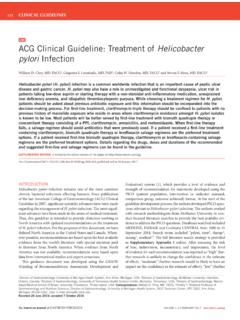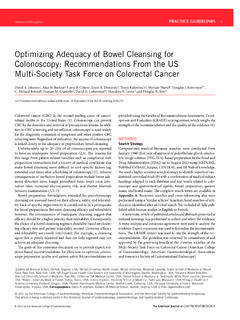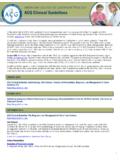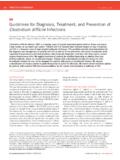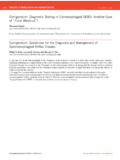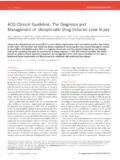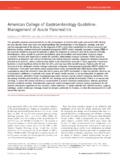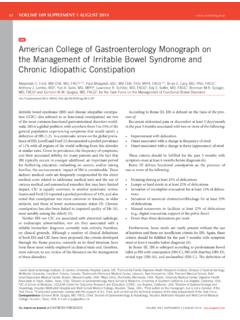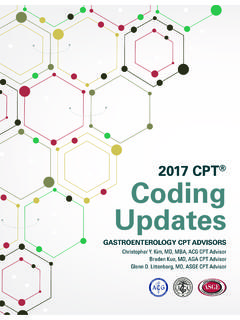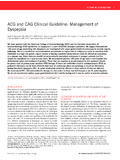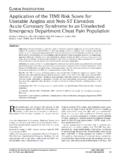Transcription of ACG Clinical Guideline: Diagnosis and …
1 Nature publishing group1 2015 by the American College of Gastroenterology The American Journal of GASTROENTEROLOGYPRACTICE guidelines Recent population studies suggest that gastroesophageal refl ux disease (GERD) is increasing in prevalence, both in the United States and worldwide ( 1,2 ). Th e Diagnosis of GERD is associated with a 10 15% risk of Barrett s esophagus (BE), a change of the normal squamous epithelium of the distal esophagus to a co-lumnar-lined intestinal metaplasia (IM). Risk factors associated with the development of BE include long-standing GERD, male gender, central obesity ( 3 ), and age over 50 years ( 4,5 ). Th e goal of a screening and surveillance program for BE is to identify in-dividuals at risk for progression to esophageal adenocarcinoma (EAC), a malignancy that has been increasing in incidence since the 1970s ( 6,7 ). Th e purpose of this guideline is to review the defi nition and epidemiology of BE, available screening modalities for BE detec-tion, rationale and methods for surveillance, and available treat-ment modalities including medical, endoscopic, and surgical techniques.
2 In order to evaluate the level of evidence and strength of recommendations, we used the GRADE (Grading of Recom-mendations Assessment, Development and Evaluation) system ( 8 ). Th e level of evidence ranged from high (implying that fur-ther research was unlikely to change the authors confi dence in the estimate of the eff ect) to moderate (further research would be likely to have an impact on the confi dence in the estimate of eff ect) to low (further research would be expected to have an important impact on the confi dence in the estimate of the eff ect and would be likely to change the estimate) or very low (any estimate of eff ect is very uncertain). Th e strength of a recommendation was graded as strong when the desirable eff ects of an intervention clearly outweighed the undesirable eff ects and as conditional when there was uncertainty about the tradeoff s. We used meta-analyses or systematic reviews when available, followed by Clinical trials and cohort and case control studies.
3 In order to determine the level ACG Clinical Guideline: Diagnosis and Management of Barrett s Esophagus N i c h o l a s J . S h a h e e n , M D , M P H , F A C G 1 , Gary W. Falk , MD, MS, FACG 2 , Prasad G. Iyer , MD, MSc, FACG 3 a n d Lauren Gerson , MD, MSc, FACG 4 Barrett s esophagus (BE) is among the most common conditions encountered by the gastroenterologist. In this document, the American College of Gastroenterology updates its guidance for the best practices in caring for these patients. These guidelines continue to endorse screening of high-risk patients for BE; however, routine screening is limited to men with refl ux symptoms and multiple other risk factors. Acknowledging recent data on the low risk of malignant progression in patients with nondysplastic BE, endoscopic surveillance intervals are attenuated in this population; patients with nondysplastic BE should undergo endoscopic surveillance no more frequently than every 3 5 years.
4 Neither routine use of biomarker panels nor advanced endoscopic imaging techniques (beyond high-defi nition endoscopy) is recommended at this time. Endoscopic ablative therapy is recommended for patients with BE and high-grade dysplasia, as well as T1a esophageal adenocarcinoma. Based on recent level 1 evidence, endoscopic ablative therapy is also recommended for patients with BE and low-grade dysplasia, although endoscopic surveillance continues to be an acceptable alternative. Given the relatively common recurrence of BE after ablation, we suggest postablation endoscopic surveillance intervals. Although many of the recommendations provided are based on weak evidence or expert opinion, this document provides a pragmatic framework for the care of the patient with BE. SUPPLEMENTARY MATERIAL is linked to the online version of the paper at Am J Gastroenterol advance online publication, 3 November 2015; doi: 1 Division of Gastroenterology and Hepatology, University of North Carolina at Chapel Hill , Chapel Hill , North Carolina , USA ; 2 Division of Gastroenterology, University of Pennsylvania Perelman School of Medicine , Philadelphia , Pennsylvania , USA ; 3 Division of Gastroenterology and Hepatology, Mayo Clinic Minnesota , Rochester , Minnesota , USA ; 4 Division of Gastroenterology, California Pacifi c Medical Center and Department of Medicine, University of California, San Francisco , San Francisco , California , USA.
5 Correspondence: Nicholas J. Shaheen, MD, MPH, FACG, Division of Gastroenterology and Hepatology, University of North Carolina School of Medicine, University of North Carolina at Chapel Hill , CB 7080 , Chapel Hill , North Carolina 27599-7080 , USA . E-mail: Received 19 March 2015 ; accepted 28 August 2015 Shaheen et al. The American Journal of GASTROENTEROLOGY VOLUME XXX | XXX 2015 2of evidence, we entered data from the papers of highest evidence into the GRADE program (accessible at ). For each recommendation, a GRADE table was constructed, and the evidence rated. Recommendation statements were structured in the PICO format (patient population involved, intervention or Indicator assessed, comparison group, and patient-relevant out-come achieved) when possible. Th e aggregate recommendation statements are in Ta b l e 1 . As part of this guideline preparation, a literature search was conducted using Ovid MEDLINE from 1946 to present, EMBASE 1988 to present, and SCOPUS from 1980 to present using major search terms and subheadings including Barrett esophagus, Barrett oesophagus, epithelium, goblet cells, metaplasia, dysplasia, precancerous conditions, adenocarcinoma, radio-frequency, catheter ablation, early detection of cancer, mass screening, and/or esophagoscopy, Th e full literature search strat-egy is demonstrated in Supplementary Appendix 1 online.
6 Diagnosis OF BE Recommendations 1 . BE should be diagnosed when there is extension of salmon-colored mucosa into the tubular esophagus extending 1 cm proximal to the gastroesophageal junction (GEJ) with biopsy confi rmation of IM (strong recommendation, low level of evidence). 2 . Endoscopic biopsy should not be performed in the presence of a normal Z line or a Z line with <1 cm of variability (strong recommendation, low level of evidence). 3 . In the presence of BE, the endoscopist should describe the extent of metaplastic change including circumferential and maximal segment length using the Prague classifi cation (conditional recommendation, low level of evidence). 4 . Th e location of the diaphragmatic hiatus, GEJ, and squa-mocolumnar junction should be reported in the endoscopy report (conditional recommendation, low level of evidence). 5 . In patients with suspected BE, at least 8 random biopsies should be obtained to maximize the yield of IM on histology.
7 In patients with short (1 2 cm) segments of suspected BE in whom 8 biopsies may be unobtainable, at least 4 biopsies per cm of circumferential BE, and one biopsy per cm in tongues of BE, should be obtained (conditional recommendation, low level of evidence). 6 . In patients with suspected BE and lack of IM on histology, a repeat endoscopy should be considered in 1 2 years of time to rule out BE (conditional recommendation, very low level of evidence). Summary of evidence Establishing a Diagnosis of BE . BE has been traditionally defi ned as the presence of at least 1 cm of metaplastic columnar epithelium that replaces the stratifi ed squamous epithelium normally lining the distal esophagus. Th e reason why such segments <1 cm have been classifi ed as specialized IM of the esophagogastric junction (SIM-EGJ) and not BE is because of high interobserver variability, as well as the low risk for EAC. Patients with SIM-EGJ have not demonstrated an increase in the development of dysplasia or EAC in large cohort studies aft er long-term follow-up, in contrast with patients with segments of IM >1 cm ( 9 ).
8 Th e defi nition of BE has varied depending upon the require-ment for the presence of IM on endoscopic biopsy. Th e presence of IM has traditionally been a requirement for the Diagnosis of BE in the United States. On the other hand, guidelines from the United Kingdom have considered BE to be present if there was visual evi-dence of columnar-lined epithelium (CLE) on endoscopic exami-nation and biopsies demonstrated columnar metaplasia, regardless of the presence of IM ( 10 ). Th e debate regarding the requirement of IM on biopsy from CLE segments has derived from the appar-ently diff erential risk of developing EAC in CLE containing IM compared with non-IM CLE. Large population-based cohort stud-ies have demonstrated a substantially lower EAC risk in subjects with columnar metaplasia without IM compared with those with IM ( 11 ). However, not all studies have corroborated this fi nding ( 12 ).
9 Although DNA content abnormalities appear to be compara-ble in both metaplastic epithelium without goblet cells compared with metaplastic epithelium with goblet cells, other studies sug-gest that cancer most commonly occurs in columnar metaplasia with goblet cells compared with columnar metaplasia without gob-let cells ( 11,13,14 ). Even if the rate of EAC is markedly higher in CLE containing IM, another complicating factor is sampling error leading to misclassifi cation of IM-containing CLE as non-IM CLE. Th e yield for IM correlates directly with the number of endoscopic biopsies obtained. In a large retrospective study, the yield for IM was 35% if 4 biopsies were obtained, and up to 68% aft er 8 biopsies were performed ( 15 ). Despite the incompletely elucidated risk of EAC in non-IM CLE, and acknowledging the potential for sam-pling error, we continue to suggest that only CLE containing IM be defi ned as BE, given the apparent diff erential cancer risk between CLE containing IM and CLE without IM.
10 Until and unless fur-ther work substantiates a markedly elevated risk of EAC in non-IM CLE patients, it is unwise to give these patients a disease Diagnosis that has a documented negative impact on insurance status and quality of life ( 16,17 ). IM of cardia is very common, being described in up to 20% of asymptomatic subjects presenting for routine open access endo-scopic examinations ( 18 ). Studies have suggested that IM of the cardia is not more common in BE patients compared with con-trols ( 19 ), and that the natural history of IM at the EGJ is asso-ciated with Helicobacter pylori infection and not associated with EAC ( 20 ). Based on this information, biopsy of a normal or slightly irregular EGJ is not recommended. Th e location of the EGJ has been defi ned as the anatomic region where the distal extent of the tubular esophagus is in contact with the proximal extent of the gastric folds.
